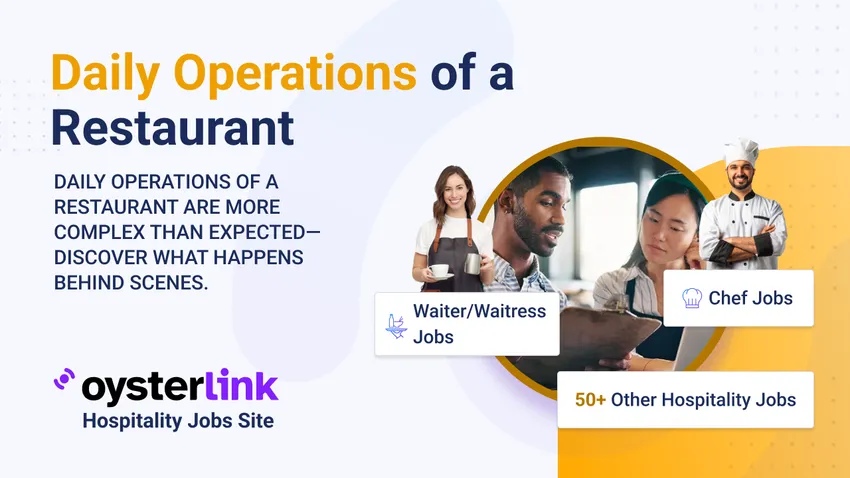Daily operations of a restaurant involve far more than opening the doors and serving guests.
Behind every smooth shift is a network of processes—from staffing and prep to financial oversight—that keeps the business running at high efficiency.
This guide breaks down how restaurant operations are structured, who handles what, and how each moving part contributes to a seamless dining experience.
What Are Restaurant Operations?
A restaurant operation covers the daily management of a food service establishment. Behind the scenes, each team handles tasks that keep workflow smooth and guests satisfied.
The kitchen is the core of operations, where the Cooks or the Chefs and their team create the menu and prepare the dishes. They're also called the back-of-house team.
Meanwhile, the front-of-house includes Hosts/Hostesses, Servers, Food Runners and Bussers who directly provide hospitality and service to the guests.
What Are the Aspects of Daily Restaurant Operations?
These are the different aspects that make up a restaurant's daily operations, with each one contributing to the overall success of the dining establishment.
Supply Chain Management in Daily Restaurant Operations
A restaurant's inventory can be categorized into the following:
Food and raw ingredients:
- Dry goods (e.g., coffee beans, pasta and spices)
- Dairy (e.g., milk, poultry and cheese)
- Meat and seafood
- Fresh produce (fruits and vegetables)
- Wine and beverages
Supplies and consumables:
- Kitchen equipment
- Linens and towels
- Tableware (plates, glasses and cutlery)
- Napkins and other disposables
- Employee uniforms
Purchasing and inventory management commonly falls to the Kitchen Manager or the Head Chef, especially when it comes to raw ingredients, produce and kitchen supplies.
For non-kitchen items, it is usually the Restaurant General Manager who oversees procurement and dealing with suppliers.
Staff Scheduling in Restaurant Operations
How well planned the staff schedule is directly impacts operational efficiency.
For instance, adequate staffing during peak hours is crucial, while overstaffing during slow periods is ineffective as it negatively affects the restaurant's costs.
The common scheduling types for restaurant staff members include:
- Fixed shift
- Rotating shift
- Split shift
- Swing shift:
- Overtime shift
The Restaurant Manager or a designated Shift Manager is responsible for staff scheduling. They consider the employee's availability, projected customer traffic and labor costs to create optimal schedules.
Food Preparation in Daily Restaurant Operations
Food preparation means turning raw ingredients into dishes through careful planning, cooking, and plating.
The kitchen team must track ingredients closely to ensure they’re fully stocked for the day.
The Executive Chef or Head Chef leads the entire process, from menu development to final execution.
Many kitchens also have Sous Chefs who supervise the Line Cooks and Prep Cooks handling specific tasks.
Daily Service in Restaurant Operations
As we've mentioned, the restaurant staff is divided into two teams:
- The front-of-house (FOH) team - responsible for all customer-facing aspects of a restaurant.
- The back-of-house (BOH) team - the behind-the-scenes operations of a restaurant, which mainly happens in the kitchen.
The seamless coordination between the FOH and BOH teams is crucial for a restaurant's success. For instance, the Cooks rely on the Waiters/Waitresses to accurately communicate the customer orders and preferences.
Cleanup, Sanitation and Hygiene in Restaurant Operations
The cleanup and sanitization happen before the restaurant opens, during operating hours and after closing. Meaning, it's a continuous task throughout the daily operations of a restaurant.
The Bussers are primarily in charge of wiping tables, floors, equipment and utensils. Meanwhile, Dishwashers clean and sanitize all kitchenware and help maintain a clean kitchen environment.
Food Waste Management in Daily Restaurant Operations
Food waste is a huge problem in the U.S. In a 2022 data, it was estimated that 38% of the 235 million tons of food supply in the country become surplus food.
From that number 33% are thrown away while the rest are donated or recycled. Reducing food waste not only creates a positive environmental impact, but also saves the restaurant a lot of money.
Financial Management in Restaurant Operations
Managing a restaurant's finances involves the following:
- Cash flow management
- Inventory control
- Daily sales tracking
- Labor cost management
- Overhead costs control
- Pricing strategy
- Payment processing
Energy Efficiency Practices in Daily Restaurant Operations
Incorporating energy-efficient practices into daily restaurant operations can lead to significant cost savings and promote environmental sustainability.
Strategies include:
- Upgrading to energy-efficient appliances
- Regular maintenance of equipment
- Utilizing LED lighting
- Implementing smart thermostats
- Training staff on energy conservation
Top Trends and Innovations in Restaurant Operations
The restaurant industry is continuously transforming, driven by technological advancements and evolving consumer preferences. Here are some of the most prominent trends right now.
Technology-driven Innovations
These technologies are revolutionizing the restaurant industry, optimizing operations and automating processes:
- Kitchen display system (KDS)
- Inventory management software:
- Labor management tools
- Online reservation systems
- Contactless payment solutions
- Customer relationship management (CRM) systems
- Employee scheduling software
Customer Preference-driven Innovations
Changing customer demands and preferences are reshaping the restaurant landscape, leading to these trends:
- Personalized dining
- Experiential dining
- Local and seasonal sourcing
Daily Operations of a Restaurant: Conclusion
Running successful daily restaurant operations demand meticulous planning, organization and coordination.
From the strategic decisions of the management to the precise execution of the staff, every role contributes to a well-oiled machine.
A well-coordinated effort among the Managers and other staff members is vital for delivering exceptional customer experiences and achieving long-term profitability.













Loading comments...